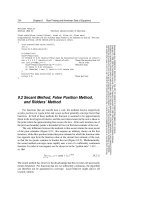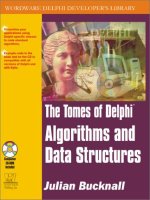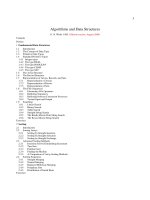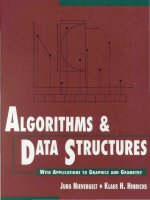Algorithms and Data Structures in C part 3 pptx
Bạn đang xem bản rút gọn của tài liệu. Xem và tải ngay bản đầy đủ của tài liệu tại đây (142.01 KB, 6 trang )
satisfies this case.
(b) (a
n - 1
= 1) For this case
By noting that
The assignment of b
k
with
satisfies the condition. The two cases can be combined into one assignment with b
k
as
The sign, a
n - 1
, of A is simply extended into the higher order bits of B. This is known as sign-
extension. Sign extension is illustrated from 8-bit 2’s complement to 32-bit 2’s complement in
Table 1.5.
Table1.52’s
Complement
Sign
Extension8‐
Bit
32‐Bit
0xff 0xffffffff
0x0f 0x0000000f
0x01 0x00000001
0x80 0xffffff80
0xb0 0xffffffb0
1.1.5C++ProgramExample
This section demonstrates the handling of 16-bit and 32-bit data by two different processors. A
simple C++ source program is shown in Code List 1.3. The assembly code generated for the C++
program is demonstrated for the Intel 80286 and the Motorola 68030 in Code List 1.4. A line-by-
line description follows:
•Line#1:The68030executesamovewinstructionmovingtheconstant1totheaddress
wherethevariableiisstored.Themovew—moveword—instructionindicatestheoperationis
16bits.
The 80286 executes a mov instruction. The mov instruction is used for 16-bit operations.
•Line#2:SameasLine#1withdifferentconstantsbeingmoved.
•Line#3:The68030movesjintoregisterd0withthemovewinstruction.Theaddwinstruction
performsaword(16‐bit)additionstoringtheresultattheaddressofthevariablei.
The 80286 executes an add instruction storing the result at the address of the variable i.
The instruction does not involve the variable j. The compiler uses the immediate data, 2,
since the assignment of j to 2 was made on the previous instruction. This is a good
example of optimization performed by a compiler. An unoptimizing compiler would
execute
movax,WORDPTR[bp‐4]
addWORDPTR[bp‐2],ax
similar to the 68030 example.
•Line#4:The68030executesamoveq—quickmove—oftheimmediatedata3toregisterd0.
Alongmove,movel,isperformedmovingthevaluetotheaddressofthevariablek.Thelong
moveperformsa32‐bitmove.
The 80286 executes two immediate moves. The 32-bit data is moved to the address of the
variable k in two steps. Each step consists of a 16-bit move. The least significant word, 3,
is moved first followed by the most significant word,0.
•Line#5:SameasLine#4withdifferentconstantsbeingmoved.
•Line#6:The68030performsanaddlonginstruction,addl,placingtheresultattheaddressof
thevariablek.
The 80286 performs the 32-bit operation in two 16-bit instructions. The first part consists of an
add instruction, add, followed by an add with carry instruction, adc.
Code List 1.3 Assembly Language Example
Code List 1.4 Assembly Language Code
This example demonstrates that each processor handles different data types with different
instructions. This is one of the reasons that the high level language requires the declaration of
specific types.
1.2 Floating Point Representation
1.2.1IEEE754StandardFloatingPointRepresentations
Floating point is the computer’s binary equivalent of scientific notation. A floating point number
has both a fraction value or mantissa and an exponent value. In high level languages floating
point is used for calculations involving real numbers. Floating point operation is desirable
because it eliminates the need for careful problem scaling. IEEE Standard 754 binary floating
point has become the most widely used standard. The standard specifies a 32-bit, a 64-bit, and an
80-bit format.
Previous TableofContents Next
Copyright © CRC Press LLC
Algorithms and Data Structures in C++
by Alan Parker
CRC Press, CRC Press LLC
ISBN: 0849371716 Pub Date: 08/01/93
Previous
TableofContents Next
1.2.1.1IEEE32BitStandard
The IEEE 32-bit standard is often referred to as single precision format. It consists of a 23-bit
fraction or mantissa, f, an 8-bit biased exponent, e, and a sign bit, s. Results are normalized after
each operation. This means that the most significant bit of the fraction is forced to be a one by
adjusting the exponent. Since this bit must be one it is not stored as part of the number. This is
called the implicit bit. A number then becomes
The number zero, however, cannot be scaled to begin with a one. For this case the standard
indicates that 32-bits of zeros is used to represent the number zero.
1.2.1.2IEEE64bitStandard
The IEEE 64-bit standard is often referred to as double precision format. It consists of a 52-bit
fraction or mantissa, f, an 11-bit biased exponent, e, and a sign bit, s. As in single precision
format the results are normalized after each operation. A number then becomes
The number zero, however, cannot be scaled to begin with a one. For this case the standard
indicates that 64-bits of zeros is used to represent the number zero.
1.2.1.3C++ExampleforIEEEFloatingpoint
A C++ source program which demonstrates the IEEE floating point format is shown in Code List
1.5.
Code List 1.5 C++ Source Program
The output of the program is shown in Code List 1.6. The union operator allows a specific
memory location to be treated with different types. For this case the memory location holds 32
bits. It can be treated as a long integer (an integer of 32 bits) or a floating point number. The
union operator is necessary for this program because bit operators in C and C++ do not operate
on floating point numbers. The float_point_32(float in=float(0.0)) {fp =in} function
demonstrates the use of a constructor in C++. When a variable is declared to be of type
float_point_32 this function is called. If a parameter is not specified in the declaration then the
default value, for this case 0.0, is assigned. A declaration of float_point_32 x(0.1),y; therefore,
would initialize x.fp to 0.1 and y.fp to 0.0.
Code List 1.6 Output of Program in Code List 1.5
The union float_point_64 declaration allows 64 bits in memory to be thought of as one 64-bit
floating point number(double) or 2 32-bit long integers. The void float_number_32::fraction()
demonstrates scoping in C++. For this case the function fraction() is associated with the class
float_number_32. Since fraction was declared in the public section of the class float_-
number_32 the function has access to all of the public and private functions and data associated
with the class float_number_32. These functions and data need not be declared in the function.
Notice for this example f.li is used in the function and only mask and i are declared locally. The
setw() used in the cout call in float_number_64 sets the precision of the output. The program
uses a number of bit operators in C++ which are described in the next section.
1.2.2BitOperatorsinC++
C++ has bitwise operators &, ^, |, and ~. The operators &, ^, and | are binary operators while the
operator ~ is a unary operator.
•~,1’scomplement
•&,bitwiseand
•^,bitwiseexclusiveor
•|,bitwiseor
The behavior of each operator is shown in Table 1.6.
Table1.6
Bit
Operators
inC++a
b a&b a^b a|b ~a
0 0 0 0 0 1
0 1 0 1 1 1









